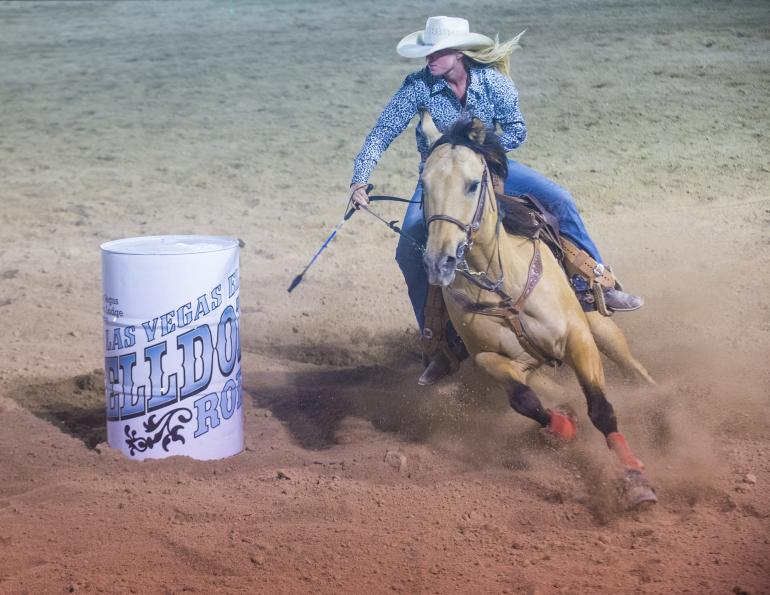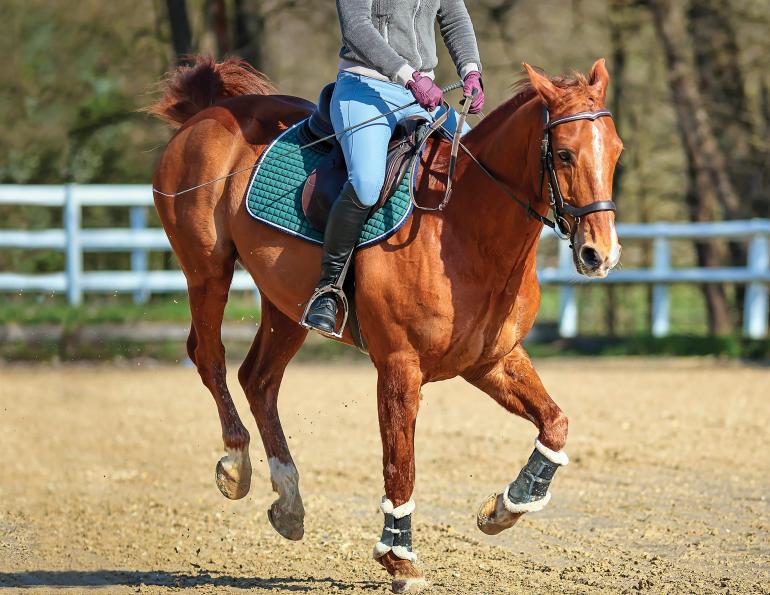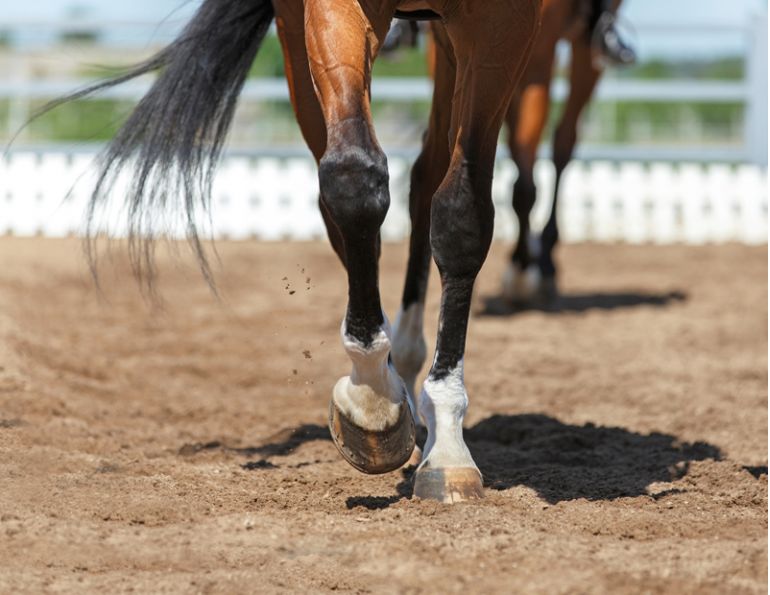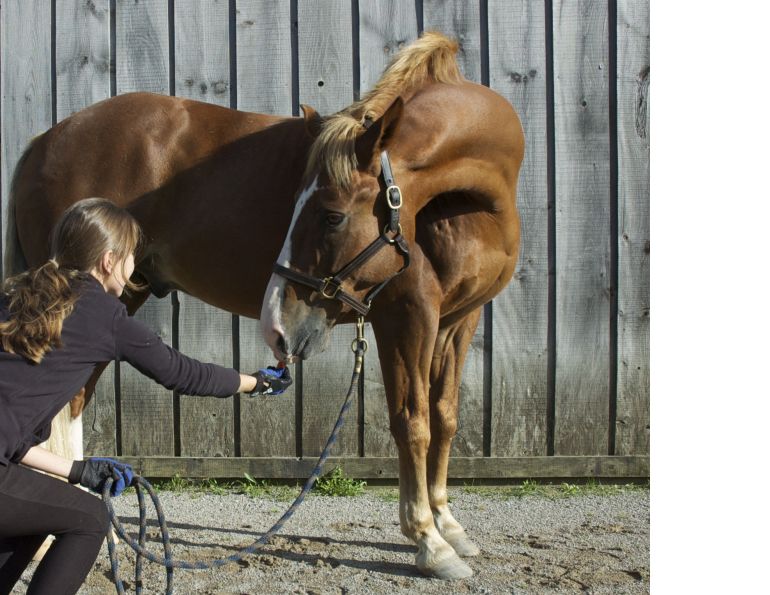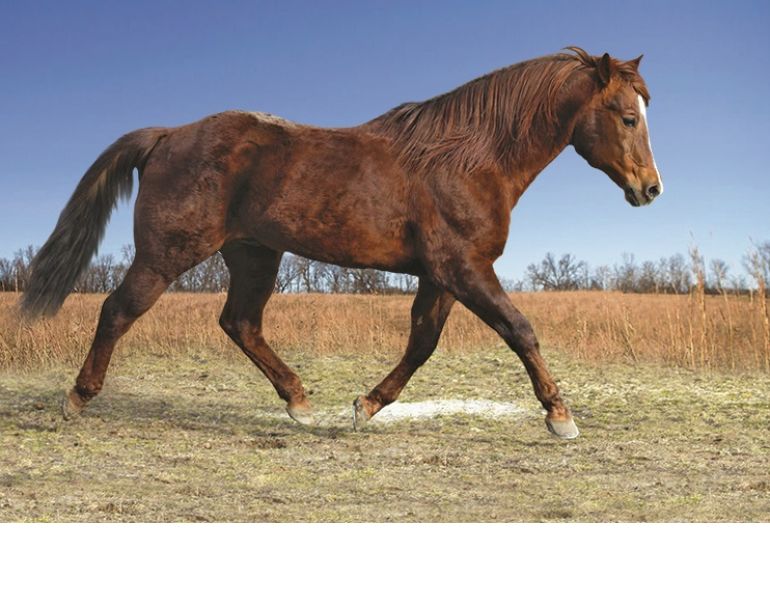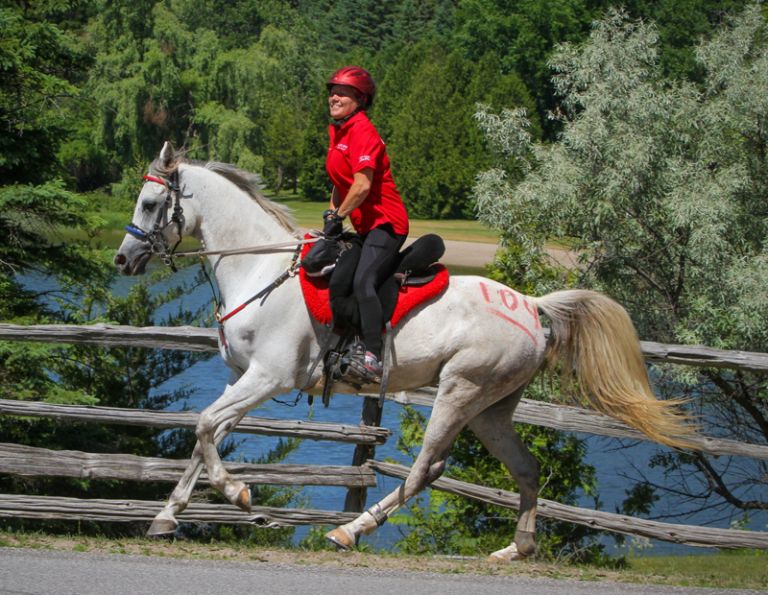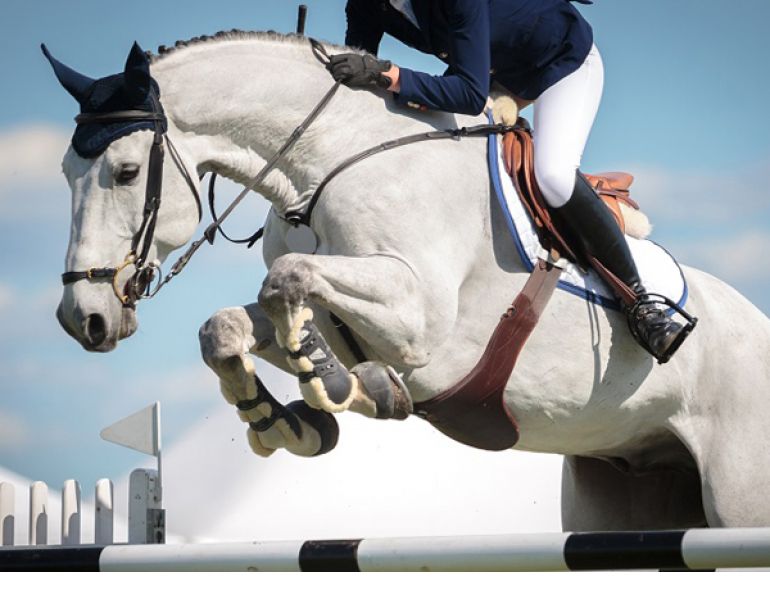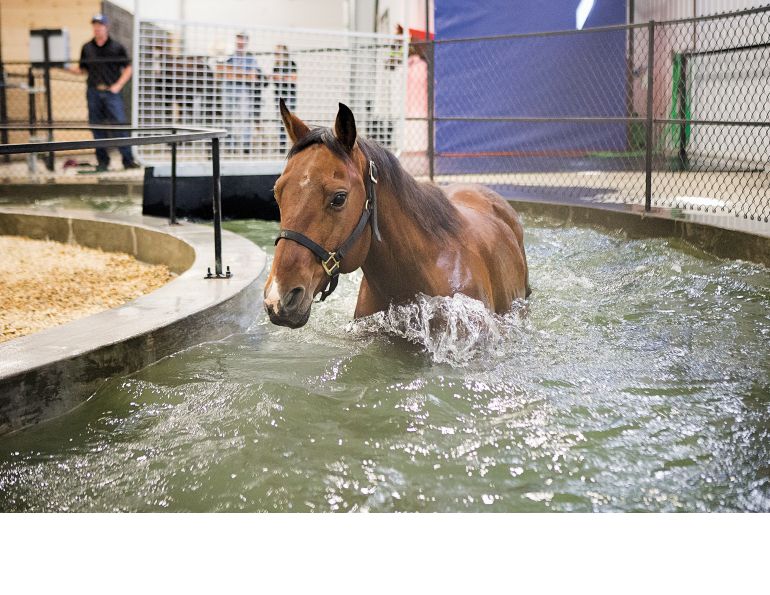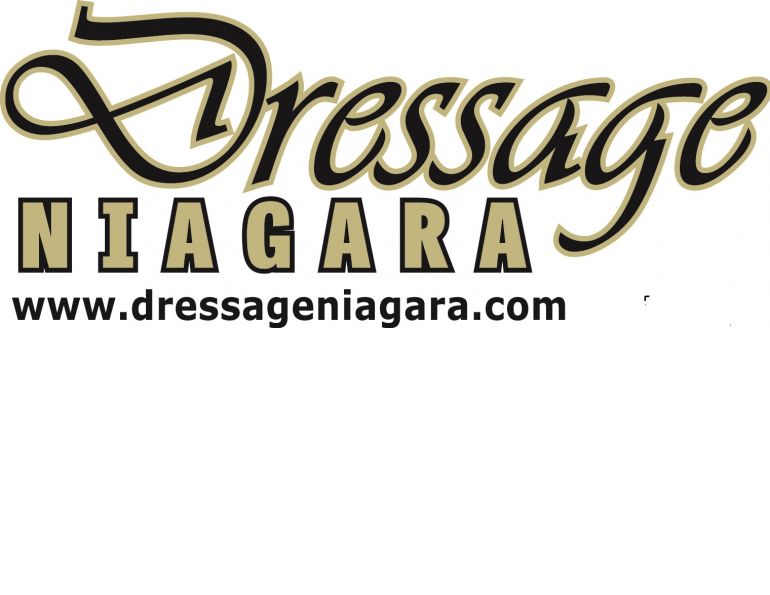By Jess Hallas-Kilcoyne
Despite their strength and grace, horses can be notoriously prone to a range of injuries, from torn tendons and ligaments to fractured bones. Over the past two decades a host of rehabilitation technologies have emerged, all intended to speed up recovery from various lamenesses. How do these therapies work? How effective are they? And how do they fit in with the traditional principles of rehabilitation: rest, heat, and compression? Coming up with an answer requires careful separation of fact from fiction by examining the science behind each therapy.
Hyperbaric Oxygen Therapy (HBOT)
Hyperbaric Oxygen Therapy (HBOT) involves the inhalation of high levels of oxygen in a pressurized environment. At normal atmospheric pressure, the amount of oxygen in the blood is fixed and even inhalation of pure oxygen will produce only a relatively small increase in the blood stream. However, at higher pressure, typically 1.5 to 3 times normal atmospheric pressure, blood plasma can carry higher levels of oxygen and thus oxygen delivery to injured areas of the body can be enhanced.
While HBOT has been used for many years in hospitals in the treatment of a variety of conditions including decompression sickness for deep sea divers, carbon monoxide poisoning, and burn victims, it is only in the past decade or so that we have seen this therapy applied to equine patients.

Hyperbaric Oxygen Therapy has been used to treat a variety of equine conditions, from soft tissue injuries to hypoxia in foals. Photo courtesy of Bar None Ranches
As in humans, HBOT has been used to treat a wide range of medical ailments in horses. “Mostly soft tissue injuries,” says Mike Vanin, Equine Division Manager of Bar None Ranches in Dewinton, Alberta, describing the conditions that Bar None treats with their equine hyperbaric chamber. “Bowed tendons, tears in tendons, lacerations, some of the really bad osteomyelitis cases, tying up, hypoxic foals...we’ve also treated really bad subcutaneous infections in there and they respond really well.”
The first experimental equine hyperbaric chamber was created in Vancouver, BC, in 1999 by the subsequent founders of Equineox Technology. Since then a host of chambers have been installed at various rehabilitation centers throughout the United States, and Canada is beginning to follow suit.
Although HBOT is becoming increasingly popular, at this point relatively little research has been done to determine the effectiveness of the therapy at treating specific conditions in equines. According to equine veterinarian and certified Equine Rehabilitation Therapist Dr. Jodie Santarossa of Brightside Vet and Consulting, one of the problems with the equine hyperbaric chamber is that “we throw everything in it. For some things it’s really effective, particularly for some infections, but we don’t really know yet how effective it is for soft tissue injuries.”
Infrared Therapy (IRT)
We are all familiar with the benefits of a heating pad in relieving the soreness and stiffness of muscle strain, but heat also promotes healing. Heat stimulates the blood supply to the affected area which provides extra oxygen and nutrients to damaged tissue as well as assisting in the removal of waste products.
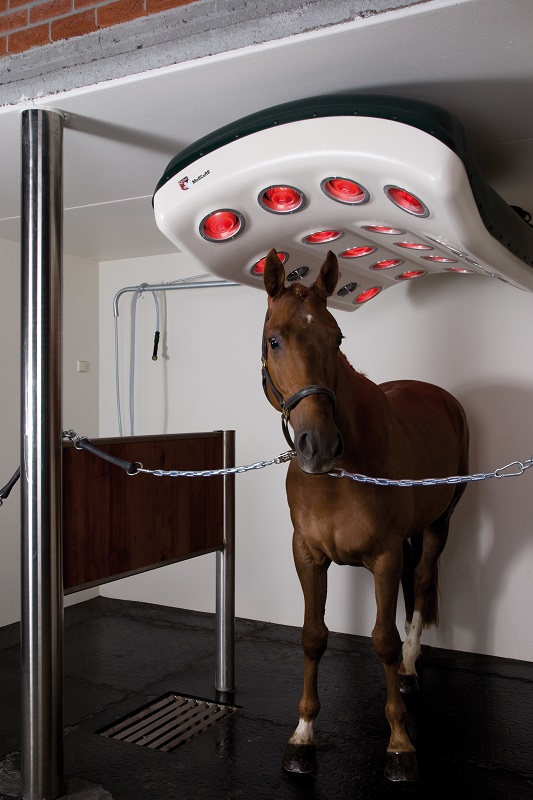
Infrared therapy, most commonly administered via an overhead solarium, relieves muscle soreness and stiffness and stimulates blood circulation, which facilitates healing. Photo courtesy of Innovative Equine Systems, www.equinesystems.com
Known by a variety of terms including light therapy and phototherapy, infrared therapy (IRT) uses infrared radiation to stimulate molecules which produces a thermal reaction in the tissue and thereby increases blood circulation. While such radiation is present in “normal” light – just think of the warmth we feel on a sunny day – the rays do not penetrate very deeply into the skin. In IRT, the infrared units enable the rays to penetrate under the skin to a depth of 1.5 to 2.8 inches (4 to 7 cm), which facilitates recovery in muscles, joints, and bones. While technically not an emerging technology (IRT has been used to treat equine injuries for over 40 years), its popularity has grown significantly over the past 20 years.
Commonly, IRT is delivered using a solarium which consists of a bank of infrared lights in a fixture which is suspended above the horse. In addition to rehabilitation, these units are commonly used for preventative purposes to improve elasticity before activity, especially in cold weather.
“It stimulates blood flow and gets everything circulating,” says Norah Ross, manager of Foxstone Stable in Duncan, BC, of Foxstone’s overhead solarium. As a bonus, “there’s a fan on it that blows warm air. If you’re bathing a horse in the wintertime, you can almost blow-dry it.”
Besides overhead solariums, infrared therapy can also be administered via fitted horse blankets, leggings, and neck wraps or hoods. F.I.T.T. Equine, a facility in Didsbury, Alberta, makes use of their infrared blanket “any time they’re prone to tying up or they’re a little tight or body sore,” says owner Janice Tokar.
One manufacturer has recently developed hand-held LED devices which produce infrared radiation. Placed on the surface of the horse’s skin for a short period of time, these enable more precise targeting of injured areas.
Stem Cell Therapy
Stem cells are biological cells which can act as a repair system for humans and animals. Of particular significance is the fact that such cells can divide into different specialized cell types and have the capacity to self-renew to produce more stem cells.
While not without controversy, since 1960 there has been extensive research and development in the use of stem cell therapy to treat a wide range of human injuries and diseases. However, the application of such therapies in the equine world is of much more recent vintage.
“Stem cell therapy is still in its infancy,” says Dr. James Carmalt, equine surgeon and Professor at the Western College of Veterinary Medicine at the University of Saskatchewan. “I think we are looking at the tip of the iceberg.”
Some of the earliest work has focused on its use in treating horses with injured tendons or ligaments. These injuries often result in the production of scar tissue which lacks the flexibility and strength of the original tendon or ligament tissue. In severe cases, it may produce a permanent loss of mobility. Even in less severe cases, the risk of re-injury will be very high. Researchers claim that stem cell therapies can avert these outcomes. Since stem cells have the capacity to become a range of different cell types, they enable the production of new tendon or ligament tissue rather than scar tissue. The procedure involves removing stem cells from the animal’s healthy tissue, usually located in bone marrow or fat, culturing the stem cells in a laboratory, and then injecting the cells into the injured area.
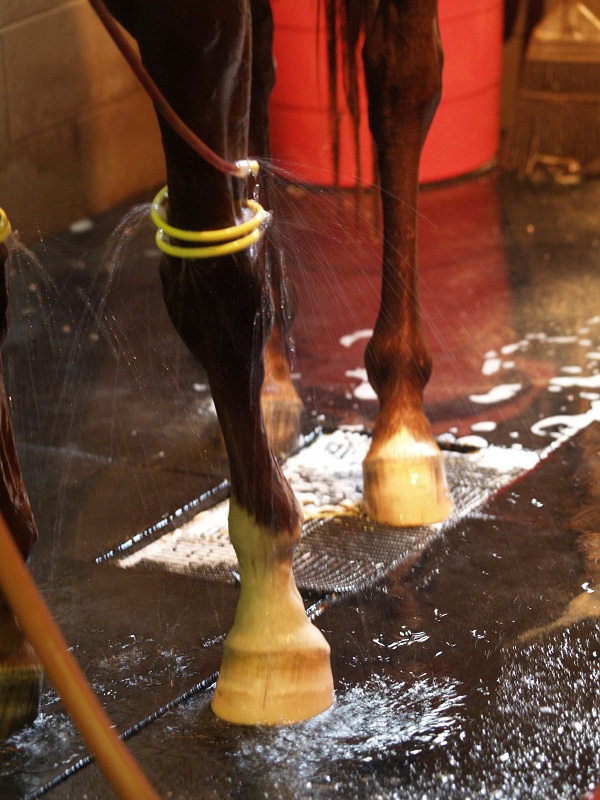
Stall rest and cold hosing are recommended by veterinarians as treatment for most soft tissue injuries and post-surgical cases. The use of emerging technologies should be used as an adjunct, not a replacement, for these more traditional rehabilitative practices. Photo: Pam Mackenzie Photography
There are currently a number of researchers worldwide who are working on the development of stem cell therapy for equines – most commonly for use in the horse racing industry. However, at the present time there is little information as to how stem cell therapy might best be utilized in the treatment of various equine lamenesses.
“There has been very, very little scientific evidence to say, for example, that a suspensory ligament lesion that is two weeks post-injury will respond whereas one that is three weeks or one that is brand new will not,” Dr. Carmalt says. “We just don’t have the data yet.”
Extracorporeal Shockwave Therapy
Extracorporeal Shockwave Therapy (ESWT) involves the production of an acoustic energy wave which can penetrate skin and fat tissue to reach muscles, ligaments and tendons, or bone. Long used in the treatment of kidney stones, heel spurs, and “tennis elbow” in humans, the last decade has witnessed growing interest in the use of this technology to treat equine injuries.
While somewhat similar to ultrasound, the pressure wave used in ESWT is hundreds of times more powerful. When the wave strikes denser material in the body, the resulting impact causes micro-trauma to the injured area. The theory is that this micro-trauma will prompt an increase in blood flow to the injured area that promotes rapid healing. However, Dr. Carmalt is quick to point out that this has not actually been proven.
The most common application has been the treatment of soft tissue injuries, but ESWT has been used to treat a variety of other ailments including navicular disease, arthritis, and, in the case of famed racehorse, I’ll Have Another, a sore back. While preliminary studies indicate that ESWT may prove to be a useful option in the treatment of certain injuries, researchers in this field caution that an accurate and complete diagnosis is an essential requirement before ESWT is employed, lest it cause greater damage.
One effect of ESWT is a numbing of the nerves in the treated area. “We know that shockwave therapy reduces nerve conduction velocity,” Dr. Carmalt explains. “So it reduces pain, which is one of the reasons why it’s banned on certain racetracks.”
Numbness is experienced immediately following treatment and takes up to two to four days to subside, but reduced nerve conductivity may be present for up to three weeks. During this time, horses are at increased risk of sustaining further injury. At this point, as with HBOT and stem cell therapy, much work still needs to be done on developing safe guidelines for the level and frequency of ESWT treatments.
Hydrotherapy
A broad field, hydrotherapy refers to the use of water to relieve pain and treat injury. While the principles of hydrotherapy have been recognized in human and equine medicine for thousands of years, newer modalities such as the underwater treadmill are gaining popularity as a tool for conditioning and rehabilitation.
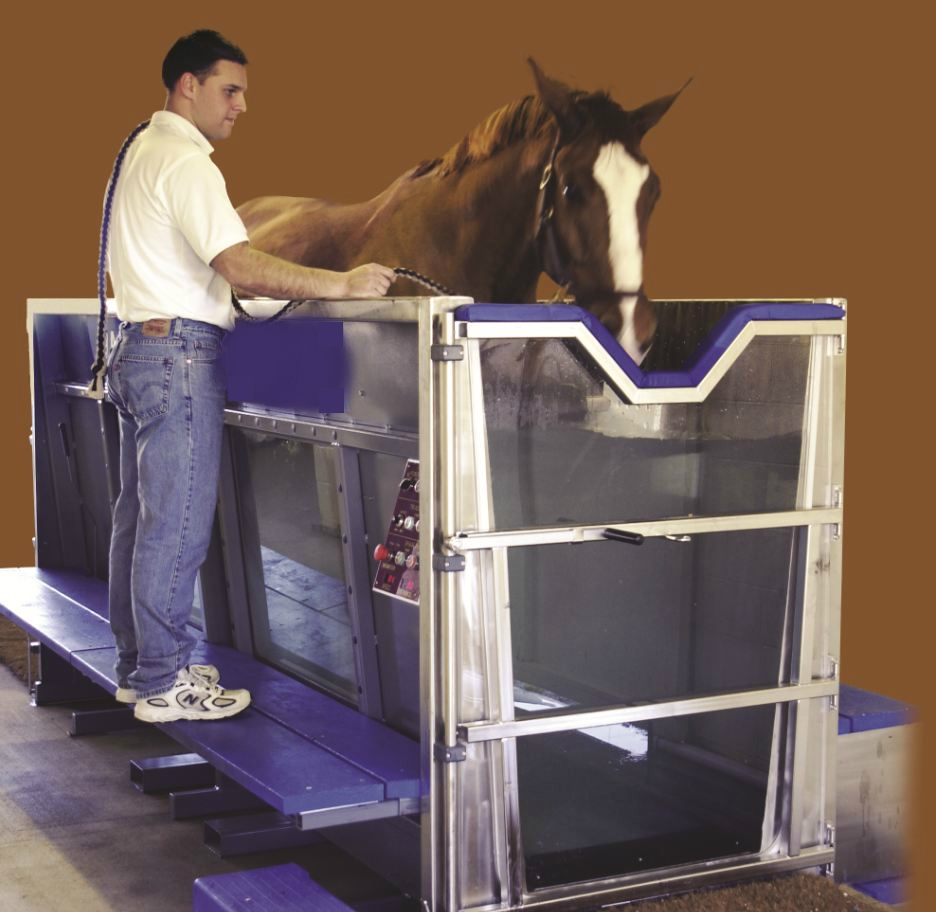
The buoyancy achieved by a horse in an underwater treadmill allows for reduced weight-bearing while the density of the water provides excellent resistance for conditioning work. Photo courtesy of Hudson Aquatic Systems, www.HudsonAquatic.com
Most commonly used in the treatment of weight-bearing soft tissue injuries and joint disease, the underwater treadmill is an above ground apparatus which contains the horse and can be filled with water to varying depths according to the nature of the horse’s injury and his fitness level. “The deeper the water, the more weight is off the limbs,” says F.I.T.T. Equine’s Tokar.
“I had a stallion that had a very traumatic patellar injury and he was starting to go laminitic because of the weight bearing issue,” Vanin at Bar None Ranches says. “We would fill up the water [to his shoulders] so that he had a certain amount of buoyancy and it was taking the weight off his legs, and we’d just stand him in there.” At some points the stallion was actually floating, recalls Vanin.
The proposed benefit of hydrotherapy as a rehabilitation therapy is that the patient can retain cardiovascular fitness and muscle tone while avoiding full weight-bearing. Hydrotherapy can also be used to condition performance horses as the density of the water offers an excellent medium for resistance training. “They try to walk up through the water,” Tokar explains, “so it really makes them use their muscles.”
Traditional Rehabilitation vs. Emerging Technologies
So how do these emerging technologies fit with more traditional practices for rehabilitation of equine lameness, such as stall rest, bandaging, icing, and controlled exercise such as hand-walking?
“Let’s assume I had access to anything I wanted and I had a horse with a tendon injury,” Dr. Carmalt says. “I’m still going to box [stall] and wrap that horse following an ultrasound examination for four to six weeks, then I’m going to re-ultrasound it. Then, in combination with increasing weight-bearing exercise, which is walking in-hand or under saddle, I’m going to put that horse on the water treadmill or in the swimming pool as well, but I’m not using them exclusively...it’s a combination therapy.
You might be thinking that this sounds like a lengthy process...and you’d be right. “Anyone who’s rehabbed a horse correctly knows how time-consuming it is,” says Foxstone’s Ross, noting that for most soft tissue injuries or post-surgical cases a veterinarian will prescribe stall rest, and twice-daily hand-walking and icing as the basis of a rehabilitation program, with the addition of other therapies as needed.
The key here is that these therapies are additional. While many of the emerging technologies are almost certainly of benefit to the rehabilitation process, it is extremely important to remember that they are an adjunct, not a replacement, for traditional rehabilitation practices.
Above all, when faced with rehabilitating a lame or injured horse, your first step should always be to consult with your veterinarian. He or she will be able to tailor a custom rehabilitation program, giving your horse its very best chance for recovery.
The information in this article is for information purposes only and should not be relied upon as a substitute for professional veterinary and/or medical advice. No liability will accrue to the publisher or author of the article in the event that a user suffers loss as a result of reliance upon the information.
Main article photo: The demands we make of performance horses can leave them at increased risk of injury. Photo: Dreamstime/Kobby Dagan
This article originally appeared in the July 2012 issue of Canadian Horse Journal.



